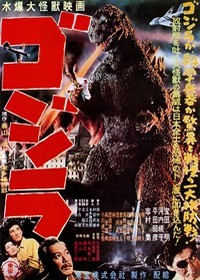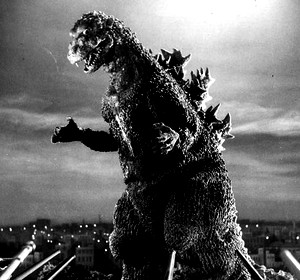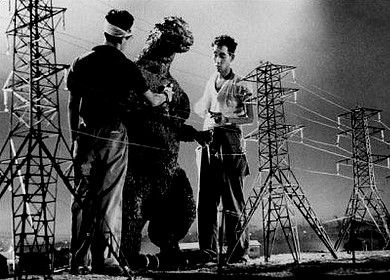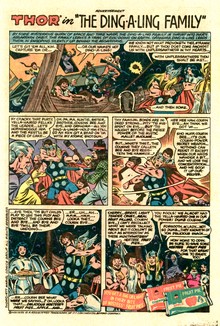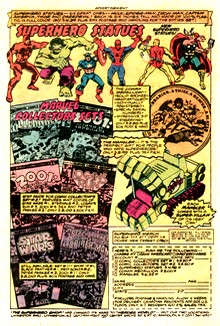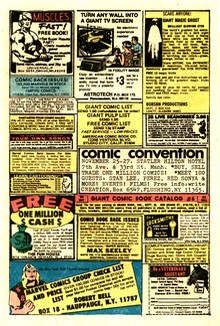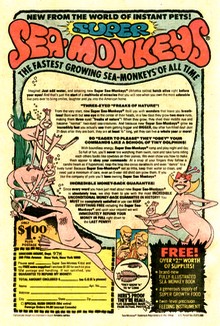 |
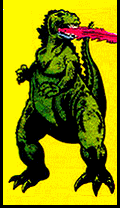 |
|
SPOTLIGHT
ON
KULL,
GODZILLA &
THE THING
BACK
TO BACK IN A
FEBRUARY
1978 MARVEL MULTI-MAGS
|
|
|
|
| |
|
| |
|
| |
|
| |
 |
|
Even in the early
1960s, the comic book industry
realized that in spite of the
hugely successful comeback of the
superhero genre (which had been
clinically dead for most of the
1950s) and the subsequent streak
of new creativity and the
enthusiasm it generated, its
traditional sales points were
fading away. Small stores which
had carried comic books were
pushed out of business by larger
stores and supermarkets, and
newsagents started to view the low
cover prices and therefore tiny
profit margins comics had to
offer as a
nuisance. |
|
|
|
| |
| Many ideas
on how to turn these developments around were put forward
by different publishers, but the most successful concepts
strived to open up new sales opportunities and markets
and thus tap into a new customer base. And one place
these potential buyers could be found was the growing
number of supermarkets and chain stores. But in order to
be able to sell comic books at supermarkets, the product
would have to be adjusted. |
| |
| Handling
individual issues clearly was no option for these
outlets, but by looking at their logistics and
display characteristics, DC Comics (who came up
with the Comicpac concept in 1961) found
that the answer to breaking into this promising
new market was to simply package several comic
books together in a transparent plastic bag. This
resulted in a higher price per unit on sale,
which made the whole business of stocking them
much more worthwhile for the seller. The simple
packaging was also rather nifty because it
clearly showed the items were new and untouched,
while at the same time blending in with most
other goods sold at supermarkets which were also
conveniently packaged. |
|
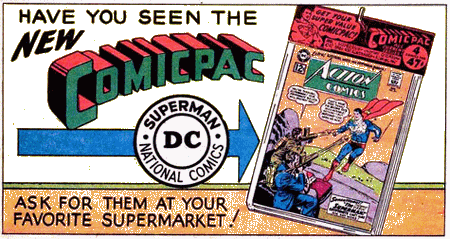 |
|
| |
| Outlets were even supplied with
dedicated Comicpac racks, which enhanced the
product appeal even more since the bags containing the
comic books could be displayed on rack hooks in an
orderly and neat fashion. |
| |
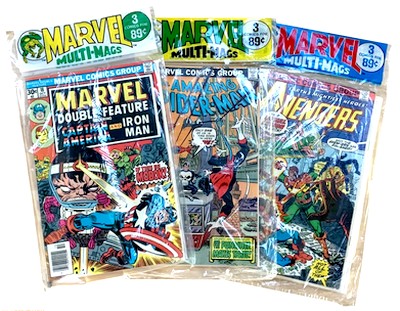
|
|
DC's
"comicpacks" were a success -
so much so that other publishers quickly
started to copy it. Marvel produced a
series of Marvel Multi-Mags in
1968/69 but then seems to have dropped
the idea again. However, by the
mid-1970s, the House of Ideas had
once again fully embraced the marketing
concept of selling multiple comic books
packaged in a sealed plastic bag to a
customer base which comic books could
hardly reach otherwise: people shopping
at supermarkets and large grocery stores. It didn't really
matter therefore that buying these three
comic books in a comicpack for say 89¢
(rather than from a newsagent for 90¢ in that case) clearly presented no
real bargain - it was the opportunity and
convenience to pick up a few comics at
the same time parents and adults did
their general shopping. Neatly packaged,
it almost became an entirely different
class of commodity.
|
|
|
| |
|
| |
| The MARVEL MULTI-MAGS we are looking at
here features three titles - Kull the Destroyer #25,
Godzilla #7, and Marvel Two-In-One #36,
all from the February 1978 cover date run, which meant
they were actually on sale at newsagents in November 1977
- although there could be quite a delay in terms of
actual availability at some sales points, resulting in
Multi-Mags on display which contained "semi-recent
books (typically about nine months old)"
(Brevoort, 2007). Considering the packaging and
distribution process, this doesn't really seem too
surprising. |
| |
| There
is no general rule to state what shape/grade the
comic books in a MARVEL MULTI-MAGS (or any other comic pack for
that matter) will be in. After all, a lot of
things can go wrong during their 40+ years of
storage. Some of these potential mishaps
will only affect the plastic bag, others might
not harm the packaging as much as the contents.
As a result, almost any combination is possible:
you can have a polybag displaying lots of wear
but perfect comic books inside (meaning it was
mostly stored in a dark and cool place but at
some time took some external soiling or slight
mechanical abrasion), but you can just as well
have a near pristine polybag holding comic books
showing substantial paper degradation (indicating
the bag was stored well but exposed to light and
excessive warmth for an extended period of time).
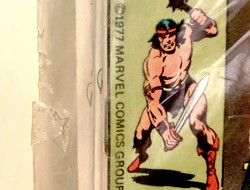 |
|
Given its age, the polybag of
this February 1978 MARVEL
MULTI-MAGS is fairly clean, with only some
slight dulling of the plastic. It did,
however, suffer some minor physical
damage at one point in time - a small
tear on one side of the bag. As no part of
the plastic had actually been ripped
away, the damage remained minor and did
not affect the integrity of the bag. The three comic books
contained in this polybag were therefore
not exposed to any physical damage as a
result.
|
No
titles had permanent slots in the MARVEL MULTI-MAGS, although Marvel
Two-In-One featured often and regularly over
many years. Godzilla only made it into
Multi-Mags regularly once it reached double digit
issue numbers, and while a few issues of Kull
could be found now and then in Marvel's
comicpacks as well, it was a more elusive title.
The way
individual issues were selected for inclusion in MARVEL MULTI-MAGS does at times seem
somewhat haphazard, and there was certainly no
guarantee of an uninterrupted flow of consecutive
issues even with regular titles such as, for
example, Marvel Two-In-One. Missing out
on parts of a storyline was therefore a distinct
possibility. On top of this, the continuity of
the Marvel Universe of the 1970s was such that
plots and storylines usually evolved over more
than one issue.
This didn't exactly make the MULTI-MAGS an ideal way of getting
your Marvel comic book fix. However, one needs to bear in
mind that this was a common fate of the average
comic book reader in the 1970s Bronze Age,
whether his or her comic books came packaged in a
plastic bag or as single issues from a display or
spinner rack. Back in those days, an
uninterrupted supply of specific titles simply
was not guaranteed. Not worrying too much about
possible gaps in storylines became something of a
routine - besides, you would usually get a recap
of what had happened so far on the first page.
All in all it simply was
a part of being a comic book fan in the 1970s -
just as the monthly Bullpen Bulletins
(which were the responsibility of the
editor-in-chief) and the in-house advertising
were. The famous alliterative and
somewhat nonsensical titles for the Bullpen
Bulletins had stopped after the end of the
alphabet had been reached with the June 1977
cover date production cycle (Cronin, 2018), but
the typical house style remained.
Stan Lee's
"cosmos spanning" (his own words)
Soapbox column featured a verbose admission
of a planning mishap which had seen Lee make a
big mystery of Marvel's new magazine Pizzaz
while the same issues carried a full page ad
revealing it all.
|
|
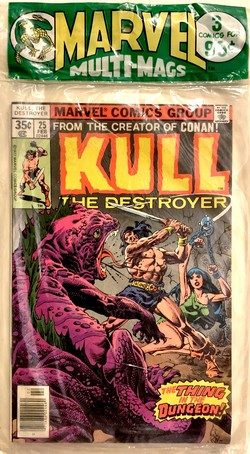 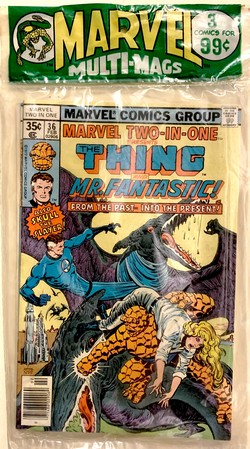
|
|
| |
But such was the avuncular tone of his monthly
ramblings that Stan "the Man" could turn an
editorial gaffe into simply another opportunity to plug
each and any Marvel product (in this case a made-for-TV
Hulk movie), just like that.
"[Stan Lee]
simultaneously bragged about the greatness of Marvel
and expressed such humility that when they screwed
up, as they occasionally did, you were willing to cut
them a lot of slack." (Evanier, 2003)
|
| |
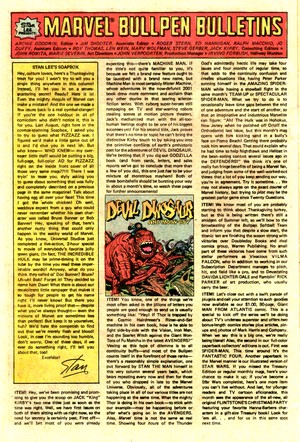
|
|
As for the actual Bullpen
Bulletins' various ITEM! bullet
points, they were mostly concerned with
Marvel's continuous launch of new titles
(while others might get cancelled, of
course), and the spotlight in this
Bullpen Bulletin was on two new Jack
Kirby titles, Devil Dinosaur and
Machine Man (who had actually
featured, albeit it as Mister Machine, in
Kirby's by then cancelled 2001: A
Space Odyssey). One specific ITEM! bullet
point, however, stood out.
"You
know, one of the things we're most
often asked in the jillions of
letters you people are good enough to
send to us is usually something like:
"Hey! If Thor is trapped by the
Cosmic Hairdresser's Rinse-and-Set
machine in his own book, how is he
able to fight side-by-side with the
Vision, Iron Man, and the Scarlet
Witch against the Giant Won-Tons of
Fu Manchu in the latest
AVENGERS?" Vexing as this type
of dilemma is to all continuity buffs
- and most of the bullpen counts
itself in the forefront of those
ranks - there's a reasonably simple
explanation, one put forward by STAN
THE MAN himself in this very column
several years back, which bears
repeating every now and then for
those of you who dropped in late to
the Marvel Universe. Obviously, all
of the adventures taking place in all
of our various titles are not
happening at the same time. What the mighty
Thor is doing in his own book - to
stick with our example - maybe
happening before or after what's
going on in the AVENGERS."
|
|
|
"Also, Marvel Time is not the same
as real time. Showing four hours of the Thundergod's
admittedly hectic life may take four issues and four
months of regular time, so that adds to the
continuity confusion and creates situations like,
having Peter Parker sunning himself in the AMAZING
SPIDER-MAN while having a snowball fight in the same
month's TEAM-UP or SPECTACULAR SPIDER-MAN. What we
try to do is to occasionally leave time gaps between
the end of one adventure and the start of another, so
that an imaginative and industrious Marvelite can
figure "Ah! the Hulk was in Hohokus, New Jersey,
when he polished off Orloff the Orthodontist last
issue, but this month's mag opens with him kicking
sand in a bully's face on Pismo Beach! Getting there
probably took him several days. That could explain
why he had time to help Nighthawk and Hellcat in the
bean-eating contest several issues ago in DEFENDERS!
We think it's one of really fun fringe benefits of
being a Marvel fan, and judging from some of the
well-worked-out theses that a lot of you keep sending
our way, you're in agreement."
"Marvel
Time" - which for instance begged the question why
Peter Parker hadn't aged that much in 15+ real time years
of being Spider-Man - was at the time a hot topic amongst
editors and writers at Marvel, along with how much change
could or should be brought to certain characters (Stan
Lee back in his editorial days had always advocated a
mere "illusion of change"), and it almost seems
as though this discussion spilled over into this (rather
lengthy) Bullpen Bulletins bullet point.
Apart from
being informative, though, it also highlighted the Marvel
house style of it being totally okay to poke fun at their
own characters. It was, of course, an echo and a legacy
of Stan Lee's approach - we're amongst friends here, we
can have a good laugh together and know we're only
joking.
The fact that comic books and
real time were always in somewhat of a flux was also made
clear by a short by-the-way plug in this Bullpen Bulletin
reminding "younger readers and cartoon
aficionados that this month sees the appearance of the
all-new, all original FLINTSTONES CHRISTMAS PARTY (...)
gift-size Treasury Book!" - a clear indication
of the three month gap between cover date (February 1978,
in this case) and actual on-sale date (November 1977).
That last snippet also illustrated how much Marvel was
still expanding its range of titles, now even stretching
the borders of the Marvel publishing Universe to
previously unimaginable genres through licensed
characters..
|
| |
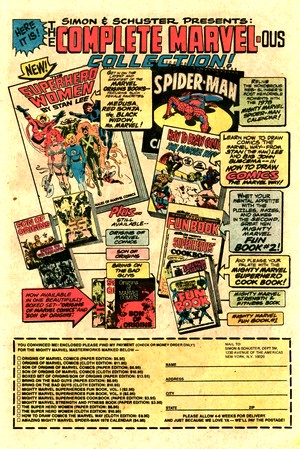 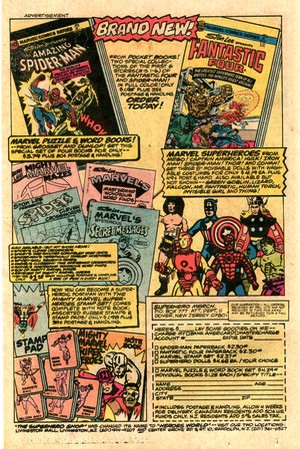 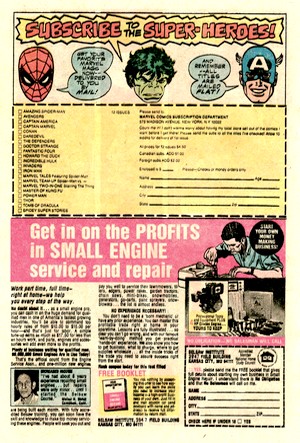 |
| |
| And finally, no 1970s Marvel
comic book was, of course, complete without the
advertising for in-house and/or licensed products - in
this case the "fireside" books published by
Simon & Schuster and a whole range of items from
reprint pocket books to 8" action figures
(surprisingly enough called "dolls"...) and
puzzle books, whilst not forgetting the omni-present
subscription ad with its usually hugely impressive list
of titles - cut short a bit here as the usually full-page
ad was cut down to half a page. |
| |
|
| |
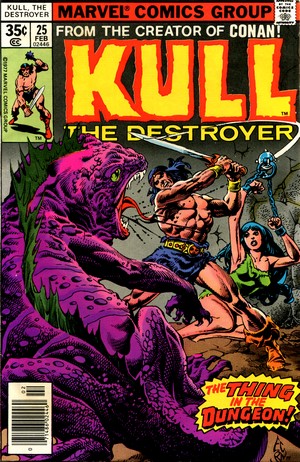
|
|
KULL
THE DESTROYER #25
February 1978
(bi-monthly)
On Sale: 1 November 1977
Editor
- Roy Thomas
Cover - Ernie Chan (pencils) & Rudy
Nebres (inks)
"A Lizard's
Throne"
(17 pages)
Story
- Don Glut
Pencils - Ernie Chan
Inks - Rudy Nebres
Lettering - Carolyn Lay
Colouring - Petra Goldberg
STORY
OVERVIEW - Contrary to
what the cover would have you think, the
woman named Laralei and Kull are actually
the rescuers here, trying to free Ridondo
from a dungeon where a giant snake-like
monster with an impenetrable hide has
been summoned by the three wizards who
abducted the minstrel.
|
|
|
| |
| Kull was created by Robert E.
Howard and preceded his popular sword and sorcery hero
Conan the Barbarian - in fact, Conan's first appearance
was a rewriting of an earlier Kull story (Byrne, 2019).
It was, of course, the other way round with Marvel
Comics, where Conan paved the way for sword and sorcery
and gave the House of Ideas one of its major success
stories of the 1970s (and, indeed, 1980s): Conan the
Barbarian (launched in October 1970) ultimately ran
for a total 275 issues until December 1993. |
| |
| Kull was introduced to readers of
marvel comic books as "King Kull" in Creatures
on the Loose #10 (March 1971) before getting his
own title, Kull the Conqueror, in June 1971.
Preceding the third major Marvel sword and
sorcery fantasy figure, Red Sonja (who made her
debut in Conan the Barbarian #23 in
February 1973), Kull ended up with a publishing
history at Marvel which was far less successful
and far more complicated than Conan's. During a
hiatus from October 1971 to June 1972 (between
issues #2 and #3 of Kull the Conqueror), he
featured (again as "King Kull") in Monsters
on the Prowl #16 (April 1972). Once the title
picked up again, Kull the Conqueror changed its
name to Kull the Destroyer as of issue #11
(November 1973) and ran up to issue #29 (October
1978) - but not without yet another publishing
hiatus from September 1974 to July 1976, between
issues #15 and #16.
|
|
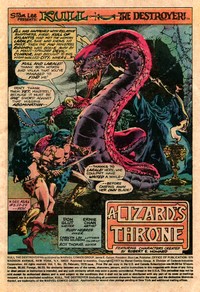 |
|
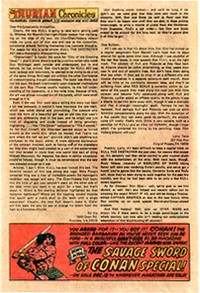 |
|
| |
| Sword and sorcery was one of
Marvel's first forays into a genre outside of superheroes
and sci-fi/horror as the House of Ideas sought to
diversify and expand its market reach at the outset of
the 1970s, and it proved a successful one (although
thanks mainly to Conan and less so to Kull). Despite the
rather chequered publication history, a number of Kull
titles made it into some MARVEL MULTI-MAGS
(although nowhere near as many as Conan the Barbarian)
towards the end of the titel's run. It was therefore even
possible to assemble a short continuous run of Kull
titles through MARVEL MULTI-MAGS - Kull
the Destroyer #24 was included in a December
1977 pack. |
| |
| And if
readers of this MARVEL MULTI-MAGS's Kull
the Destroyer #25 were to be lucky enough to
get hold of the right Multi-Mags two months
later, they would even be able to read the
story's next segment... |
|
 |
|
| |
| This was the fifth consecutive
issue of Kull the Destroyer
pencilled by Ernesto "Ernie" Chan, and he would
stay on the title until its cancellation after issue #29.
Born Ernesto Chua on July 27th 1940
in the Philippines, he had taken up drawing and inking
comics when he was twenty and emigrated to the United
States in 1970 when both Marvel and DC were looking to
the Philippine talent pool in order to recruit artists
for the growing number of titles both publishers were
putting out. |
| |
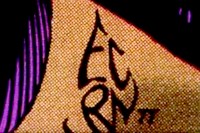
Typically ornate
Ernie Chan (EC) and Rudy Nebres
(RN) signature on the cover of
Kull #25
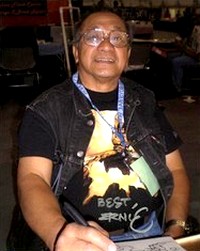
Ernie Chan in 2009
|
|
His first US
pencil work was published in DC's
Forbidden Tales of Dark Mansion
#4 (March/April 1972). Initially
credited as Ernesto Chua or Ernie
Chua, this changed quickly to the
more familiar Ernie Chan (which
he then officially adopted when
becoming a US citizen in 1976).
The quality of his work both as
penciller and inker quickly
established him at DC in a
variety of genres, and his
artwork for Batman throughout
1975 and 1976 played a
substantial part in shaping the
visuals of Batman during the
mid-1970s as Chan was putting out
covers and interior artwork that
have remained fresh and dynamic
to this day and represent some of
the best Bronze Age Batman. From early 1977
on Chan worked mostly for Marvel
where he drew and inked a whole
range of characters such as Dr.
Strange, Dracula, Daredevil, Doc
Savage, Thor, Fantastic Four
(including the Thing's team-up
adventures, see Marvel Two-In-One
#36 below), Hulk,
Powerman & Iron Fist, Kull,
John Carter of Mars, and of
course, Conan (Chan had an
amazingly extended run on Savage
Sword of Conan from 1978 up
to 1994). His work on Marvel's
fantasy and sword & sorcery
titles reflects both the genre he
is best remembered for and the
one he liked most, establishing him
as one of the finest and most
respected artists on titles such
as Conan the Barbarian, Savage
Sword of Conan and Kull
the Destroyer.
Like most
of his fellow Philippine artists
who broke into the US comic book
industry in the early to mid
1970s Ernie Chan was always spot
on the money with his work. Both
his pencil work as well as his
inking were characterized by a
steady yet very dynamic line with
an unfaltering quality - Chan
knew what he was doing, and he
had the talent to do it well each
and every time he turned to a
blank art board. The perspective
and composition he put into each
and every panel breathed life
into the pages he was producing,
and his artwork was always solid
and exciting at the same time -
just as his covers more often
than not were absolute
eye-catchers in the best of movie
poster tradition - of which Kull
#25 is an excellent example.
|
|
|
|
| |
| Chan
gradually shifted his work focus during the 1990s to
television and movie animation projects and officially
retired in 2002. He passed away on May 16th 2012 after a lengthy battle with cancer. |
| |
| |
|
| |
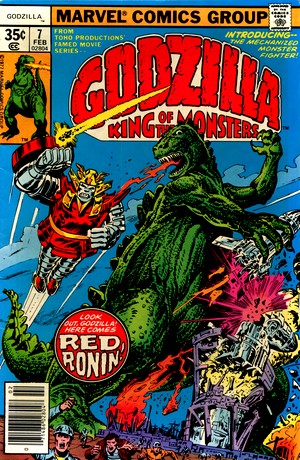
|
|
GODZILLA
#7
February
1978
(monthly)
On Sale: 1
November 1977
Editor - Archie
Goodwin
Cover - Herb Trimpe (pencils)
& Ernie Chan (inks)
"Birth
of a Warrior"
(17 pages)
Story
- Doug Moench
Pencils - Herb Trimpe
Inks - Fred Kida
Lettering - Glenn Simek
Colouring - Janice Cohen
STORY
OVERVIEW - Godzilla
is on a rampage at a San Diego
military base and is getting
dangerously close to the base's
nuclear missile stockpile before
Red Ronin arrives - a mechanized
fighter (i.e. a giant robot)
developed for S.H.I.E.L.D. to
bring Godzilla down but now
actually stolen by one of the
Japanese engineer's twelve year
old grandson whose intention it
is to help Godzilla...
|
|
|
|
| |
| Superheroes were still Marvel's bread and butter by
the end of the 1960s, but it became clear to editors (and
most prominently so to Roy Thomas) that the dropping
profit margins per single comic book could only be offset
by higher sales, and practically the only way to
accomplish this was to diversify the content of the
titles published. As a result, the 1970s saw Marvel
Comics sweep up the rights to seemingly as many outside
properties as possible, and in many cases these would be
integrated into the existing Marvel Universe. One such
example is Godzilla, the "King of Monsters". Godzilla
has a huge recognition factor, as lots of people of all
ages know the name and have a general idea of a city
stomping monster, possibly even without ever having seen
a Godzilla movie (although recent big dollar films
featuring the prehistoric sea monster awakened and
empowered by nuclear radiation may have changed that a
bit). The original Godzilla movie was made in
1954 by Toho Studios of Tokyo, and became such a success
that it spawned an entire franchise of further Godzilla
movies (which increasingly also introduced other giant
monsters). A heavily altered version of the film was
released in the United States and worldwide as Godzilla,
King of the Monsters! in 1956, featuring additional
footage shot with actor Raymond Burr.
An anecdotal piece of trivia
concerning the original Godzilla movie is the fact that -
rather than using the classic stop-motion technique
employed by other studios at the time - the producers had
an actor play the monster wearing a latex costume. In any
case, Godzilla movies are a matter of taste - people seem
to either like them a lot and or not at all.
|
| |
|
| |
Since Marvel's interest in licensing characters was
obvious by the mid-1970s, they would even sometimes be
approached by owners who felt their property could be
turned into a profitable comic book series. Such, it
would seem, was the case with Toho Studios, who organized
a special screening for Marvel of their Godzilla on
Monster Island prior to the film's U.S. theatrical
release in 1977 which turned out to be rather special
indeed.
"It was a piece of
crap, [Doug] Moench recalls, but Stan [Lee] was
sitting next to me hooting and hollering and
clapping. He went crazy during the fight scenes,
shouting, 'Go get 'em, Godzy!' (...) Roger Stern, a
Marvel editor at the time, was also at the screening.
"Stan was trying to show enthusiasm in front of
the Toho execs." (Greenberg, 2019)
The consensus among the Marvel
editorial staff present at the screening was that they
had just watched a "terrible movie with these
awful special effects" (Roger Stern, in
Greenberg 2019), but the top brass saw a sales potential
and a deal was struck. It was not the first time that the
creative talent at the House of Ideas was left to figure
out how to make a licensed character work (the Human
Fly was another example).
|
| |
| And so, Marvel launched Godzilla
- King of Monsters in August 1977. The title
would run for a total of 24 issues before bowing
out in July 1979, with the writing chores falling
to Doug Moench while all but two issues were
pencilled by Herb Trimpe. Moench
had a soft spot for the classic movie monsters
(reflected by his work on Marvel's Dracula
Lives!, Werewolf by Night and Frankenstein
Monster), but this did not include Godzilla
(Greenberg, 2019). At the time, Moench - like
many of his writing colleagues at the House of
Ideas - was pushing characters and plots aimed at
an older, more mature readership, but Godzilla
would be headed in an entirely different
direction.
"[The
neighborhood kids] were crazy about Godzilla
(...) so I told Stan that I would want to put
more emphasis on the kid angle, do things
that I thought kids would really want to see,
in a way that adults would enjoy it
too." (Moench, in Greenberg 2019)
|
|
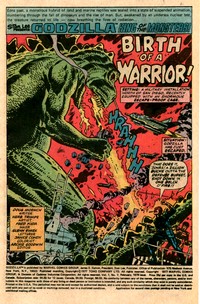 |
|
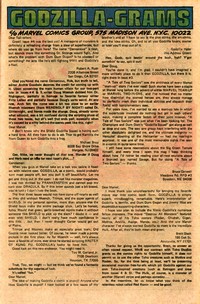 |
|
| |
| In a way, Moench simply made the best of the
assignment, and together with Trimpe basically portrayed
Godzilla as a force for good - the misunderstood outcast
you can root for. For added reader identification, he
added 12-year-old Rob Takiguchi whose grandfather, a
scientist, is called in to assist S.H.I.E.L.D. in
bringing Godzilla under control as rhe creature goes on a
rampage across the United States (a first, since he had
previously been confined to smashing Japanese cities in
the movies). The licensing contract
only included Godzilla but none of the other Toho movie
monsters which would often fight the "original"
- for financial reasons.
"We would have had to
pay Toho the same amount for each one [but] it was
such a shoestring profit margin that there was no way
Marvel could afford them." (Moench, in
Greenberg 2019)
Moench therefore simply created
his own XXL monsters for Godzilla to battle (such as the
bat mutation Batragon) as well as original villains (such
as the deranged geneticist calling himself Doctor
Demonicus) and weaved all of this into parts of the
fabric of the Marvel Universe by having S.H.I.E.L.D. and
Dum Dum Dugan play key roles. It was a decision made by
the top editorial staff even before signing the contract,
but Moench did foresee a problem.
|
| |

|
|
"Toho
owns Godzilla and we own the
Marvel characters and now we're
going to mix them together - when
the agreement expires, what's
going to happen? (...) It did
delay the series being reprinted
for a long time."
(Moench, in Greenberg 2019) |
|
|
|
| |
As with many similar titles, it was soon suggested to
Moench that he include superhero guest-stars, leading to
the Champions, Hank Pym (Ant-Man), the Fantastic Four,
the Avengers, and even Jack Kirby's very recent creation
Devil Dinosaur showing up. But what would in many ways
have been the most logical guest appearance never
happened - Godzilla never faced off with the Hulk.
"It's a wonder why we
never thought of it at the time or pushed to do it
(...) I would have loved to have drawn that!" (Trimpe,
in Greenberg 2019)
The end of Marvel's Godzilla
came about after 24 issues not due to low sales but
rather because Toho decided they wanted to double the
licensing fee when the contract for the publishing rights
came up for renewal, and as a consequence, Marvel pulled
the plug.
|
| |
| |
|
| |
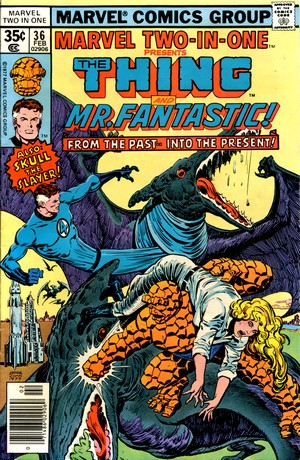
|
|
MARVEL
TWO-IN-ONE
#36
February
1978
(monthly)
On Sale: 1 November 1977
Editor - Marv
Wolfman
Cover - Ernie Chan (pencils &
inks)
"Turmoil
in the Time-Stream!"
(18 pages)
Story - Marv
Wolfman
Pencils - Ernie Chan
Inks - Ernie Chan
Lettering - Joe Rosen
Colouring - Michelle Wolfman
STORY
OVERVIEW - Wrapping
up things from Marvel Two-In-One
#35, where Ben Grimm ended up
trapped in a strange prehistoric
world after flying a new
experimental aircraft over the
Bermuda Triangle, where he finds
James "Skull" Scully
who has been trapped there for
some time. They manage to escape
back via the Bermuda Triangle but
are followed by the Jaguar Priest
and his pterodactyl-riding
followers. Mr. Fantastic helps
fight off the threat.
|
|
|
|
| |
An often overlooked and sometimes outright forgotten
fact of Marvel's range of 1970s titles and characters is
the huge popularity of the Thing at the time.
"It can’t be
overstated just how popular the Thing was during the
1970s. He was just behind Spider-Man in terms of his
draw power, the Wolverine of his era. And unlike
Wolverine over the past few decades, if you wanted to
read a story with the Thing in it, you generally
needed to be buying FANTASTIC FOUR. There’d be
an occasional guest-appearance in another title here
and there, but nothing like the world tour that
Wolverine has been on since the 1980s."
(Brevoort, 2021)
In order to tap into this popularity, Marvel tried out
teaming up the Thing with a different character for a
done-in-one story in each issue of Marvel Feature #11-12
(September and November 1973). It was a concept well and
successfully established by Spider-Man's team-up title
since Marvel Team-Up #1 launched in March 1972.
Not surprisingly, given the popularity of the character,
it worked with the Thing too. Since the obvious title was
already taken, the House of Ideas launched the Thing's
team-up adventures as Marvel Two-in-One in January 1974.
|
| |
| Ultimately locking up a total of
100 issues between then and June 1983 (plus seven
Annuals along the way), it was a steady fan
favourite (bi-monthly at first, monthly as of
issue #15). Marvel Two-in-One was also a title to
be found in many MARVEL MULTI-MAGS
throughout the late 1970s and very
early 1980s. Initially,
it was actually ideally suited for the comcipack
since the revolving door formula of changing
guest characters resulted in a new storyline
every issue.
The
downside of the single issue "done-in-one"
stories was their volatility.
Somewhat reminiscent of DC's titles of the 1970s,
heroes and foes would meet, things would happen,
and then everybody just went home. None of what
took place mattered to the next issue, which
would just start the procedural formula all over
again. Marvel readers weren't used to this, and
it caused some irritation, as the letterspage
would at times show.
|
|
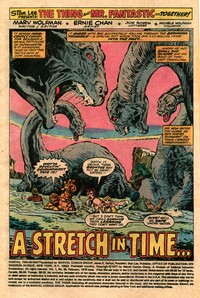 |
|
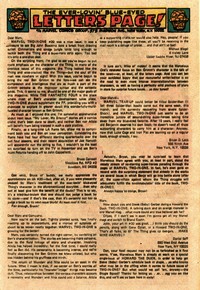 |
|
| |
| Readers also started to comment
negatively on the (rather obviously) repetitive formula
of single issue guest appearances and the resulting
done-in-one storylines. They were increasingly asking for
overarching plots and storylines that continued over more
than one issue, and that change started with a two issue
story involving Thor in Marvel Two-in-One #22-23
(December 1976, January 1977) and would soon also include
storylines spread out over multiple issues, while still
featuring the occasional done-in-one issues. |
| |
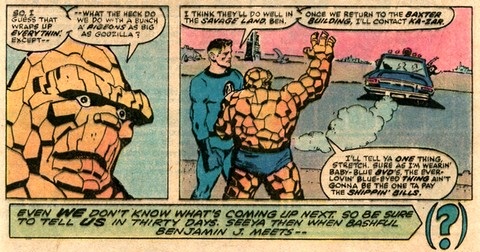 |
|
Ron Wilson was the regular
penciller for the Thing's adventures in Marvel
Two-in-One, but in this case Ernie Chan took over
for this and the preceding issue. The final panels even had a
humorous Godzilla reference (actually refering to
the pterodactyls of this story), but it seems
highly unlikely that editorial did not know who
was going to be the next guest in MTIO (as it was
sometimes refered to by way of its acronym).
It certainly tickled the
curiosity of readers and was no doubt a great
plug. And since you can't just get the next issue
in 30 days, here's who
it was (if you feel you just need to know).
|
|
| |
| A closer look at this page also
reveals some of the flaws and shortcomings of the printing techniques employed for comic
books in the 1970s on cheap newsprint paper, including
partially obliterated word balloons. Sometimes you just
had to fill in the gaps yourself... |
| |
| |
|
| |
| No 1970's
Marvel comic book was, of course, without (a lot of)
third party advertising, some of which was
"okay" (mostly if it featured Marvel
characters, such as the frequent and somewhat famous
"Twinkies" ads) and some of which was nothing
but a dismal swamp of the cheapest form of advertising
you could find - such as the flea market ads promising
anything and everything, along with the infamous
"Sea Monkeys". All three titles included in
this February 1978 Multi-Mag carried almost exactly the
same ads, some of which are illustrated here. |
| |
|
| |
|
| |
| |
 |
|
Today,
any MARVEL MULTI-MAGS is a time
capsule; opening this plastic bag
right here offers a nostalgic
glimpse into what it was like to
be a comic book reader in
February 1978. So what else
was going on back then?
|
|
|
|
| |
 |
|
The Bee
Gees were at the top of
the US Billboard Chart
throughout all of
February 1978 with
"Stayin'
Alive", while the UK
saw three top singles
that month: Althea &
Donna ("Uptown Top
Ranking") were
followed by
Brotherhood of Man
("Figaro") for
one week at the top each
before ABBA settled in at
number one with
"Take a Chance on
Me" for the rest of
the month. |
|
|
|
| |
 |
|
The New
York Times Bestseller
list for February 1978
was topped by J.R.R.
Tolkien's posthumously
published "The
Silmarillion" all
month (as it had been all
throughout January too). |
|
|
|
|
| |
 |
|
In
February 1978 "Close
Encounters of the Third
Kind" was the most
popular movie in the US.
Overall,
"Superman" was
the US top-grossing movie
while "Grease"
(a close second to
Superman in the States)
topped the 1978 list in
the UK. |
|
|
|
|
| |
 |
|
In the
US, all of the five most
popular TV shows came
from ABC, with
"Laverne &
Shirley" taking the
top spot, while the UK's
television show with the
highest number of viewers
that year was ITV's
"Sale of the
Century". |
|
|
|
|
| |
| |
| |
|
|
| |
| FURTHER
READING ON THE THOUGHT
BALLOON |
| |
| |
 |
|
"Comic
packs" not only sold well
for more than two decades, they
also offer some interesting
insight into the comic book
industry's history from the 1960s
through to the 1990s. There's
more on their general history here. |
|
|
|
| |
 |
|
There's more
on the background and the history
of the Marvel Multi Mags here. |
|
|
|
| |
 |
|
There's more
on Ernie Chan's artwork for
Batman in the mid-1970s here. |
|
|
|
| |
| |
|
| |
BIBLIOGRAPHY
| |
| |
| BREVOORT Tom
(2007) "Marvel Multi-Mags", Blah Blah Blog,
originally published online 28 April 2007,
reposted 18 April 2020 BREVOORT
Tom (2021) "BHOC: Marvel Two-In-One #30", The Tom Brevoort Experience,
published online 22 May 2021
BYRNE Bob
(2019) "Hither
Came Conan: Ruminations of "The Phoenix on
the Sword", Black Gate, published
online 22 January 2019
CRONIN Brian
(2018) "Marvel's Bullpen Bulletins, from A to Z!", CBR.com, published
online 18 February 2018
EVANIER
Mark (2003) "Notes
from Me Archives", POVonline.com, published
online 31 October 2003 (archived at
web.archive.org
GREENBERG
Glenn (2019) "When
Godzilla battled the Avengers: A History of the
Epic Crossover", Syfy Wire,
published online 7 May 2019
|
|
| |
| |
|
| |
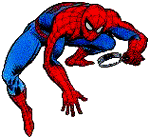 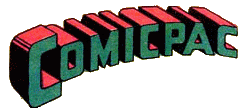 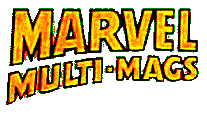
More on comic packs / More on Marvel Multi-Mags
|
| |
|
| |

(c) 2021
uploaded to the web
22 July 2021
|
| |
|
| |
|




















